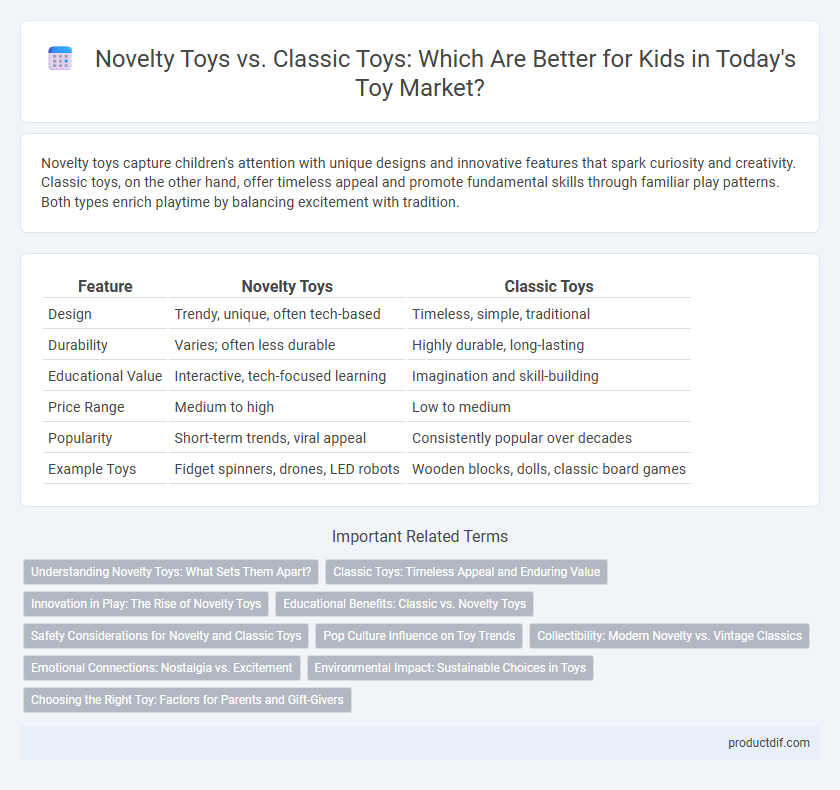Novelty toys capture children's attention with unique designs and innovative features that spark curiosity and creativity. Classic toys, on the other hand, offer timeless appeal and promote fundamental skills through familiar play patterns. Both types enrich playtime by balancing excitement with tradition.
Table of Comparison
| Feature | Novelty Toys | Classic Toys |
|---|---|---|
| Design | Trendy, unique, often tech-based | Timeless, simple, traditional |
| Durability | Varies; often less durable | Highly durable, long-lasting |
| Educational Value | Interactive, tech-focused learning | Imagination and skill-building |
| Price Range | Medium to high | Low to medium |
| Popularity | Short-term trends, viral appeal | Consistently popular over decades |
| Example Toys | Fidget spinners, drones, LED robots | Wooden blocks, dolls, classic board games |
Understanding Novelty Toys: What Sets Them Apart?
Novelty toys distinguish themselves through their unique designs, limited editions, and trend-driven appeal, often incorporating innovative materials and technology to capture instant fascination. Unlike classic toys, which rely on timeless play value and enduring educational benefits, novelty toys target short-term engagement and creativity bursts. This differentiation highlights the dynamic nature of the toy market, where novelty toys introduce fresh experiences that complement the lasting charm of classic toys.
Classic Toys: Timeless Appeal and Enduring Value
Classic toys such as wooden blocks, dolls, and board games possess timeless appeal due to their simplicity, durability, and ability to foster creativity and social interaction across generations. Unlike novelty toys that often rely on trends and technology, classic toys maintain enduring value by encouraging imaginative play and cognitive development without obsolescence. Their consistent popularity in educational and recreational settings demonstrates a lasting cultural and developmental significance.
Innovation in Play: The Rise of Novelty Toys
Novelty toys revolutionize play by integrating cutting-edge technology and interactive features that captivate children's imagination beyond traditional designs. Unlike classic toys, which rely on familiar forms and timeless appeal, novelty toys often incorporate augmented reality, smart sensors, and AI to create dynamic, personalized experiences. This surge in innovation drives engagement and educational value, positioning novelty toys as a leading force in the evolving toy market.
Educational Benefits: Classic vs. Novelty Toys
Classic toys like building blocks and puzzles develop fundamental cognitive skills, spatial reasoning, and fine motor skills through hands-on play, fostering creativity and problem-solving over time. Novelty toys often incorporate digital features and interactive elements, providing immediate engagement and technology-based learning that can enhance sensory stimulation and adaptability to new information. Both toy types contribute uniquely to educational development, with classic toys supporting foundational learning and novelty toys offering modern, technology-driven educational experiences.
Safety Considerations for Novelty and Classic Toys
Novelty toys often feature unique designs and electronic components that require stringent testing to meet safety standards such as ASTM F963 and EN71. Classic toys, typically simpler in construction, generally pose fewer risks related to small parts, choking hazards, or toxic materials but still demand verification for durability and non-toxicity. Both categories must comply with regulatory requirements including CPSIA limits on lead and phthalates to ensure child safety.
Pop Culture Influence on Toy Trends
Pop culture significantly drives toy trends, with novelty toys often reflecting the latest movies, TV shows, and viral sensations, capturing kids' immediate interests. Classic toys maintain enduring appeal by tapping into timeless themes and nostalgic value, ensuring multi-generational engagement. The dynamic between novelty toys and classic toys highlights how entertainment franchises and cultural phenomena shape consumer demand and innovation in the toy industry.
Collectibility: Modern Novelty vs. Vintage Classics
Novelty toys often feature limited edition releases and unique designs that boost their short-term collectibility among trend-driven collectors. Vintage classic toys gain enduring value due to their nostalgic appeal, rarity, and historical significance within toy collecting communities. Collectors prioritize condition, packaging, and authenticity when assessing the long-term investment potential of both modern novelty and vintage classic toys.
Emotional Connections: Nostalgia vs. Excitement
Novelty toys spark excitement through innovative designs and interactive features that engage curiosity and provide instant gratification. Classic toys evoke deep emotional connections rooted in nostalgia, often reminding adults and children alike of cherished memories and timeless play experiences. Both types of toys uniquely contribute to emotional well-being, balancing the thrill of new discoveries with the comfort of familiar favorites.
Environmental Impact: Sustainable Choices in Toys
Novelty toys often contain non-recyclable plastics and electronic components, contributing to increased environmental waste and resource depletion. Classic toys, typically made from wood or durable materials, offer greater sustainability due to their longevity and biodegradability. Choosing eco-friendly toys reduces carbon footprints and supports sustainable manufacturing practices in the toy industry.
Choosing the Right Toy: Factors for Parents and Gift-Givers
When choosing between novelty toys and classic toys, parents and gift-givers should consider factors like developmental benefits, durability, and long-term engagement. Novelty toys often feature the latest technology and trends that capture immediate interest, while classic toys provide timeless educational value and encourage imagination. Prioritizing age-appropriateness, safety standards, and a toy's ability to foster creativity ensures a well-rounded play experience.
Novelty toys vs classic toys Infographic

 productdif.com
productdif.com